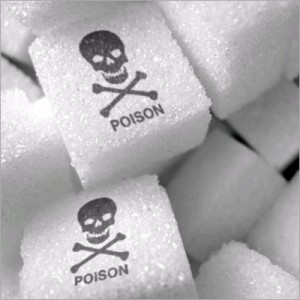![]()
It is now the Year 2013 and we all know sugar is the enemy. So, table sugar (aka poison, also known as sucrose) is appropriately in the garbage, and label reading for ‘sugar’ content is now a grocery shopping ritual. Yet, the full sugar story is only partially revealed. Sugars, like fats, are not created equal, and we must also consider the source and relative physiological effects.
There are two basic forms of sugar – glucose and fructose. While there are several forms of sugar, such as everyday table sugar, also known as sucrose, they all contain proportional amounts of glucose and fructose.
Healthy eaters and dieters alike often live under the misguided belief that fruits couldn’t possibly lead to negative health or weight gain. After all, fruit is natural, therefore the sugar found in most fruit – fructose – is natural, and what is natural is good, right?
Hmmm. True, fruit has its nutritional qualities and eating fruit is not the same as scooping granulated sugar into your tea or sprinkling it over your favorite cereal. Logical, yes, but excess fructose consumption has negative consequences, even if the source of that fructose is fruit.
Scientists using newer functional magnetic resonance imaging (fMRI) discovered that fructose can in fact trigger changes in the brain that stimulate overeating and weight gain. In a recent Journal of the American Medical Association publication, an extensive study of 20 healthy adults utilizing fMRI revealed that the brain registered suppressed hunger and fullness within 15 minutes of drinking glucose. As Dr. Robert Sherwin notes, “With fructose, we don’t see those changes. As a result, the desire to eat continues — it isn’t turned off.” In other words, glucose satiates faster than fructose.
So, when consuming a beverage containing fructose, like fruit juice, fructose not only failed to suppress appetite, it actually causes a small spike. Where glucose was shown to augment the body’s general ability to sense true satiety, fructose was not, but could rather trigger hunger pangs. The more fructose you ingest, the more prone to obesity you could be, as you program your body to consume more calories.
How Your Body Metabolizes Fructose Versus Glucose
The body also metabolizes glucose and fructose differently: of 120 calories of glucose, less than one calorie is stored as fat; whereas of 120 calories of fructose, 40 calories are stored as fat. The math is clear.
When ingesting fructose, the metabolic burden falls entirely on the liver and is converted into visceral fat far more rapidly than any other sugar. The body can’t metabolize a fructose overload and becomes a sea of toxic byproducts, including uric acid, which drives up blood pressure and causes gout. Ouch.
On the other hand, the liver is required to metabolize only 20 percent of the body’s glucose consumption. As every cell in the body, including the brain, utilizes glucose, the majority is immediately burned, making it an ideal source of energy.
Fructose is turned into free fatty acids (FFAs), VLDL (the damaging form of cholesterol), and triglycerides, which get stored as fat. These FFAs accumulate as fat droplets in the liver and skeletal muscle tissues, often causing insulin resistance and non-alcoholic fatty liver disease. Insulin resistance all too often progresses to metabolic syndrome and Type II Diabetes.
Fructose is also known as the ‘fatty’ carbohydrate, as it converts to glycerol 3 phosphate (g-3-p), which is directly used to turn FFAs into triglycerides. The more g-3-p you have, the more fat you store.
Excess fructose consumption is also a major contributor to insulin resistance and obesity, hypertension, cardiovascular disease, liver disease, cancer, arthritis and other diseases. The byproduct of visceral fat created in the abdominal region collects around organs and is associated with a greater risk of heart disease.
Beyond fruits, fructose is found today in nearly all soft drinks, juices and processed foods, typically in the form of high fructose corn syrup (HFCS). Adding insult to injury, the fructose that comes in the form of HFCS is most often made from genetically engineered corn, which is fraught with its own well-documented health concerns ranging from the development of food allergies to the risk of increased infertility, and possibly cancer.
I am NOT anti-fruit the same way I abhor processed foods and those laden with HFCS. What I am trying to make you aware of is that excess fructose, notwithstanding the source being fruit, can yield a host of very undesirable weight and health consequences.
That said, your fructose intake should be limited to fruit whenever possible. If you drink any beverage other than water or eat any packaged food, you are almost guaranteed to absorb some hidden sources of fructose. So while fruit can be a wonderfully beneficial source of vitamins, antioxidants and fiber, informed and conscious consumption is critical. Like anything, moderation matters.
As a standard recommendation, TOTAL fructose consumption should stay below 25 grams per day. To insure that, I would suggest mentally earmarking 15 of those grams for fruit at the most. That’s not much! Fifteen grams represents two bananas, one-third cup of raisins, or two Medjool dates. But, on the other hand, the average 12-ounce can of soda would fast exceed your daily allotment, with a whopping 40 grams of sugar, half of which is fructose. So beware!
Likewise, think again about fresh-squeezed fruit juice. Not only would the juice of 3 or 4 oranges exceed 15 grams fructose, all the pulp fiber from the fruit is lost. Fiber slows the absorption of sugar, helping to improve blood sugar levels, and provides countless other health benefits, such as reduced blood pressure and inflammation.
Eat, don’t drink your fruit. Moreover, try and stick to a moderately sized bowl of berries, or other high-fiber fruit, eat green leafy vegetables liberally and stay away from alcohol, sodas, juices and processed foods.
If you would like to learn more about how fructose affects your “fat switch,” I recommend The Fat Switch, by Dr. Richard Johnson.
![]()









